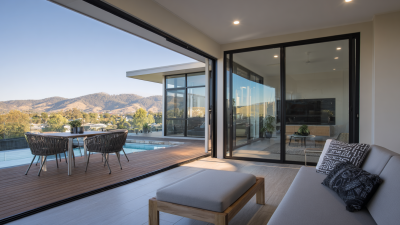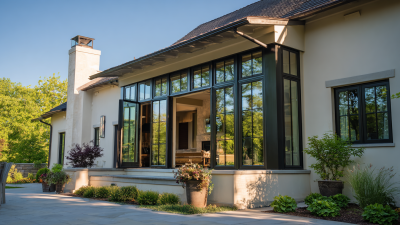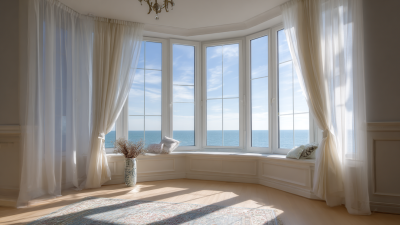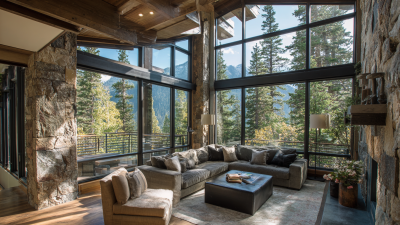Blog
7 Essential Factors Driving Commercial Windows Efficiency in 2023: Boosting Sustainability and Performance
In 2023, the emphasis on sustainability and performance in the construction sector has become more critical than ever, particularly concerning commercial windows. These essential components play a pivotal role not only in enhancing a building's aesthetic appeal but also in driving energy efficiency and reducing carbon footprints. As businesses and property owners increasingly seek ways to meet stringent environmental standards and optimize operational costs, understanding the factors that influence commercial windows efficiency is vital. This blog explores the seven essential factors that are shaping the future of commercial windows, highlighting innovative technologies, materials, and design strategies that can boost sustainability while enhancing overall performance. By focusing on these key elements, stakeholders can make informed decisions that align with eco-friendly practices and contribute to a more sustainable built environment.

The Role of Advanced Glazing Technologies in Enhancing Window Efficiency
Advanced glazing technologies play a pivotal role in enhancing window efficiency, significantly contributing to sustainability and energy performance in building design. According to the U.S. Department of Energy, windows account for approximately 25-30% of residential heating and cooling energy use. By incorporating advanced glazing features such as low-emissivity (Low-E) coatings and triple glazing, buildings can reduce energy loss by up to 30%, leading to substantial cost savings on utilities. These innovations not only help in maintaining indoor comfort but also support global efforts in reducing carbon footprints.
Moreover, the integration of smart glazing technologies, like electrochromic and thermochromic materials, is revolutionizing the commercial window market. A report from Research and Markets indicates that the global smart glass market is expected to reach USD 6.9 billion by 2026, growing at a CAGR of 12.2%. These technologies provide dynamic control over solar heat gain and light transmission, allowing buildings to adapt to changing environmental conditions. By minimizing reliance on artificial lighting and HVAC systems, advanced glazing solutions contribute to improved energy efficiency and sustainability, reinforcing their importance in modern architecture and urban planning.
Innovative Frame Materials: Balancing Durability and Energy Conservation
The choice of frame materials for commercial windows plays a pivotal role in achieving both
durability and energy conservation.
In 2023, innovative materials such as fiberglass and
composite frames are gaining traction in the market due to their remarkable strength and longevity.
Unlike traditional aluminum or vinyl frames, these new materials offer superior thermal insulation properties,
minimizing heat transfer and significantly reducing energy costs over time. This makes them an excellent choice for businesses
aiming to enhance their sustainability practices while maintaining a modern aesthetic.
Moreover, the environmental impact of window materials cannot be overlooked. The use of recycled
and sustainable materials in frame production not only reduces waste but also aligns with corporate
responsibility goals. Manufacturers are increasingly focusing on creating products that meet stringent energy efficiency standards,
ensuring that commercial spaces can maximize their operational performance. By investing in innovative frame materials, businesses not only secure a
more resilient future for their buildings but also contribute to a greener planet. The balance between
durability and energy conservation is now a critical factor in the design of commercial
windows, defining the path towards sustainable architecture in the years ahead.
Understanding the Impact of Solar Control on Interior Climate Management
When considering the impact of solar control on interior climate management, one must acknowledge how effective window systems can significantly influence energy consumption and comfort. Solar control windows are designed to minimize excessive heat gain while maximizing natural light, creating a balanced indoor environment. By strategically using these advanced glazing solutions, businesses can enhance their energy efficiency, leading to reduced HVAC costs and improved occupant comfort.
Tip 1: Invest in high-performance window films that can reflect solar radiation while allowing visible light to pass through. This allows spaces to remain bright and inviting without overheating, contributing to a more pleasant work atmosphere.
Moreover, integrating smart window technologies can further enhance solar control. Automated shading systems, for instance, can adapt to changing sunlight conditions in real-time, optimizing natural light usage and maintaining cooler indoor temperatures. This proactive approach not only supports sustainability goals but also raises employee productivity and well-being.
Tip 2: Consider implementing a smart building management system that monitors and adjusts window treatments based on external weather conditions. This can lead to significant energy savings and a more comfortable indoor climate throughout the day.
Integrating Smart Window Systems for Optimal Performance and Automation
In 2023, the integration of smart window systems is revolutionizing the commercial building landscape by enhancing energy efficiency and sustainability. With the advancement in technologies such as adjustable smart films, buildings can optimize natural light and thermal performance, significantly reducing reliance on HVAC systems. This shift not only lowers energy costs but also contributes to a greener environment, aligning with the growing demand for sustainable construction practices.
The smart window market is poised for substantial growth, projected to reach over $1.49 billion by 2032 with a compound annual growth rate of 10.6%. As businesses increasingly recognize the importance of energy-efficient solutions, the demand for automated window systems that adapt to environmental conditions is on the rise. This trend is further supported by innovations in cleaning technologies, with the window cleaning robot market expected to grow at an annual rate of 8.5%, indicating a robust interest in maintaining optimal window performance without compromising sustainability goals. Together, these advancements underscore a significant movement towards smarter, more efficient commercial spaces.
Sustainable Manufacturing Processes: Reducing Environmental Footprint in Window Production
As the demand for sustainable building solutions grows, window manufacturers are adopting innovative processes to reduce their environmental footprint. According to a report from the U.S. Department of Energy, energy-efficient windows can save homeowners up to 30% on energy costs. The move towards sustainable manufacturing begins with selecting eco-friendly materials. Many companies are now utilizing recycled glass and aluminum, which can reduce material waste by as much as 60%. This not only lowers the impact on landfills but also significantly decreases the energy required for production.
Additionally, advancements in technological processes, such as employing low-emission glass treatments, are essential to enhancing performance while maintaining sustainability. Research indicates that high-performance windows can lead to up to a 40% reduction in greenhouse gas emissions associated with residential energy use. Furthermore, optimizing supply chains by sourcing local materials minimizes transportation emissions, making the production process even greener. By focusing on sustainable practices, the commercial window industry can dramatically enhance both environmental stewardship and product efficiency in 2023 and beyond.
Related Posts
-

How to Identify Top Suppliers for the Best Sliding Patio Doors: A Global Buyers' Guide
-

The Future of Awning Windows: Innovations and Trends Shaping Tomorrow's Design
-

Navigating Global Trade Certifications for the Best Windows and Siding Solutions
-

Top Strategies for Finding the Best Bay Window Replacement Solutions
-

Innovative Uses of Best Home Windows in Sustainable Architecture What are the Benefits
-

7 Impressive Benefits of Sliding Glass Doors for Modern Homes
About Us
We serve the Greater Milwaukee area: Waukesha, Milwaukee, Washington, Ozaukee Counties and nearby areas, including Germantown, Menomonee Falls, Mequon, Cedarburg, Thiensville, Grafton, Jackson, West Bend, Hartland, Waukesha, Brookfield, West Allis, Franklin, Greenfield and more. We are Wisconsin’s Best Contractor for Replacement Windows, Doors, Siding & Roofing!
Contact Details
Address:
N112 W14880 Mequon Road
Germantown, Wisconsin 53022
Phone:
Email:
Showroom Hours
Monday: 9am – 5pm
Tuesday: 9am – 5pm
Wednesday: 9am – 5pm
Thursday: 9am – 5pm
Friday: 9am – 4:30 pm
Saturday by Appointment
Evenings by Appointment



